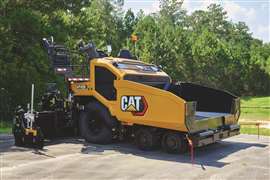Read this article in Français Deutsch Italiano Português Español
Roadbuilding: Green initiatives, infrastructure investment, and emerging technology
24 June 2024
The future will need roads, and governments across the world have announced major projects, some set to last more than a decade. Mitchell Keller reports on the road construction industry and the emerging products literally paving the way.

Prototype flying cars may well be in development, but it is the safest of safe bets to say that the world’s need for roads will only increase in the future, and 2024 will see continued annual growth in the road building sector.
Even as commuter rail networks enjoy increased financing, road builds are expected to rise at a steady rate between 2% and 5% with a projected worldwide value of up to US$3 trillion, by some estimates.
Driven by green initiatives, infrastructure investment, and emerging technology, countries are reconstructing their motorways and connecting communities.
The largest existing road network belongs the US, with approximately 6.5-million-km (4-million-miles) of motorways across America, according to data by the US Central Intelligence Agency (CIA).
The robust system is set to increase in 2024, due in large part to historic federal investment in infrastructure projects.
Analysis from Deloitte suggests major federal dollars are starting to get spent and, “there could be a boost to construction associated with manufacturing, transportation infrastructure, and clean energy infrastructure.”
This would be due to, “three key pieces of legislation passed in 2021 and 2022 – the Infrastructure Investment and Jobs Act (IIJA), the Inflation Reduction Act (IRA), and the Creating Helpful Incentives to Produce Semiconductors (CHIPS) Act.”
Billions have already been allocated for road projects, as some schemes will build new paths, and another portion of the allocation also involves road demolition or freeway removal.
“The Department of Transportation recently opened applications for more than $3 billion to reconnect communities that have been cut off from economic opportunity by highways, rail lines, or other transportation infrastructure, part of the $4 billion (€3.7 billion) Reconnecting Communities and Neighborhoods Program,” says the US White House.
Of course, not all US road builds are using government funding. One of the largest ongoing projects in the country – the North Tarrant Express (NTE) Capacity Improvement project in Texas – will be funded by future toll revenues collected from new express lanes.
 Caterpillar’s AP400 paver (Image: Caterpillar)
Caterpillar’s AP400 paver (Image: Caterpillar)
Costing approximately $414 million, the scheme will add capacity improvements on a 13-mile (21km) stretch of passage between the Texan cities of Fort Worth and Irving.
“Toll revenues collected on the [express lanes] will fully fund the project,” confirms the project’s webpage. “No public money will be used for the construction.”
The NTE project is being designed and built by North Tarrant Infrastructure, a joint venture between Dutch/Spanish multinational company Ferrovial Agroman and US-based WW Webber Construction.
Full construction activities are expected by midyear, with a completion date anticipated in early 2027.
Ambitious road building targets
In India, 2024 is expected to be another exceptional year for construction activities, and road segments will certainly be at, or near, the top of that list.
It’s a concerted effort to bolster what is the world’s second largest road network, which spans 6,371,847km (3,959,282 miles), according to estimates.
The country’s Ministry of Road Transport announced it hoped to construct 13,814km (8,584 miles) of national highways through fiscal year 2023-24, which would have been the highest achievement in history. In fiscal year 2020-21, India built 13,327km (8,281 miles) of roads.
“It’s becoming one of the world’s fastest growing economies,” says Paul Wallet, Trimble Solutions regional director for the Middle East and India, adding the regional market has been exploding particularly after the onset of the pandemic. “Construction was growing more than 10% year-over-year.”
Driving the productivity, in Wallet’s view, is a fundamental change in how India uses technology in the construction industry.
 A GOMACO GP3 paver operated by a team of roadbuilders (Image: GOMACO)
A GOMACO GP3 paver operated by a team of roadbuilders (Image: GOMACO)
“When Covid hit, many people were working more in the traditional sense, but [the pandemic] really facilitated the fact that they had to move rapidly to cloud services,” he says. “The projects couldn’t stop. They needed, with the deadlines they had, to continue work.”
He added that the need to build, coupled with pandemic restrictions, drove a shift in India, as construction there has become a viable and productive market for international tech companies in recent years.
In particular, firms based in and working in India are said to have increased adoption of new technologies from 3D modelling, cloud software, and BIM programmes.
With more advanced tools than ever before, on the docket for the near future are thousands of kilometres of road builds in the country, and one of the biggest – and most expensive – is the Bharatmala Pariyojana project.
The main goal of improving the network is to connect smaller cities and remote areas with the country’s megacities like Bengaluru, Pune, and Hyderabad. In all, the entire project will build or improve 83,677km (51,994 miles) of roads at a cost of more than $130 billion.
Advanced machines
While building roads and passages is an ancient practice, the machines and technology assisting human operators has made leaps and bounds in just the last few years. Switzerland-based Ammann says the advent of advanced tech tools has inspired portions of the industry to make wholesale upgrades.
“There is a great deal of emphasis on replacing older machine types,” reveales a company spokesperson, noting that OEMs and builders alike are looking for increases to productivity, improved ergonomics, and sustainability in road construction.
Ammann says digitalisation and electrification are driving innovation in pavers, millers, planers, and other equipment. While electric machines have reduced or zero emissions, they also produce less noise, making them ideal for “urban areas where noise can be an issue.”
Interestingly, Ammann says that data is now just as important as the hardware and, thanks to improving technology, contractors now have access to data that can lead to much better decisions on the jobsite and at the office.
“They can determine if compaction has been achieved. They can track productivity, fuel usage and a host of other efficiencies. This is a chance to uncover improvement opportunities that can be the difference between a profit or loss on a jobsite,” says the company.
 An enhanced image of the new Ammann walk-behind roller – the ARW 65-S – showing the machines multi-directional capabilities in roadworks applications (Image: Ammann)
An enhanced image of the new Ammann walk-behind roller – the ARW 65-S – showing the machines multi-directional capabilities in roadworks applications (Image: Ammann)
Smaller machines – like skid steers – have also become more prevalent on sites in recent years, as contractors seek to take some burden off the larger, harder-to-handle machines.
“In addition, machine handling is becoming increasingly important,” acknowledges Ammann. “This includes electrical/electronic systems that support or facilitate the operator’s work.”
One machine, Ammann’s ARW 65-S walk-behind compactor/roller, serves as an example of how comfort and functionality are shaping road-build machinery development.
“[It] can move forward, backward, and laterally,” says Ammann. “This makes the operator’s life much easier and boosts productivity, too.”
The world’s largest OEM – US-based Caterpillar – had a busy year, releasing six 2.5m paver models going back to 2023.
The 14 to 16 tonne weight class includes the Cat AP400, AP455 Mobil-trac, AP455 Steel Track, AP500, AP555 Mobil-trac, and AP555 Steel Track asphalt pavers. The new compact line was designed for Europe roadworks, with machines arriving onsite this year.
However, utilisation of smaller machines isn’t replacing the need for extra wide roadbuilding units.
In the US, GOMACO continues to produce sizable machines for road construction applications. One of the most popular from the company remains the GP3 Slipform Paver.
Available as either a two-track or four-track slipform paver, it can pave a width up to 30 feet (9.14m), with the automatic frame widening capabilities up to 14 feet (4.26m). It can also come loaded with modern technology in the form of information tracking and object sensing.
 A rural road runs through Valley of Fire State Park near Las Vegas, Nevada, US (Photo: AdobeStock)
A rural road runs through Valley of Fire State Park near Las Vegas, Nevada, US (Photo: AdobeStock)
“The four-track GP3’s smart leg positioning includes rotary-sensor slew drives on the pivot arms of each of the paver’s legs. The smart pivots on the legs provide the exclusive G+ control system with information on the pivot arm angle and works together with the track rotation sensors to maintain the tracks in the straight-ahead steering line,” says GOMACO.
“Rotary-sensor slew drives are also located on all four tracks for the ultimate in smart steering technology and extreme steering with the tracks having the ability to steer farther than ever before.”
Adoption of modern technology and automation should also increase health and safety standards and expectations, although the sector isn’t preparing for a wholesale takeover of roadbuilding by artificial intelligence (AI) just yet.
Paul Jaworski, products manager for US-based Minnich Manufacturing, which produces dowel pin drills and concrete paving vibrators, says, “Although the industry may never see a totally AI-operated paving machine, AI-assisted analytics will be used as a machine learning aid and turning a paver into a data driven performing product.”
Focus on sustainability
Ultimately, the world is not moving toward a future without roads or human roadbuilders, but the industry is trying to drive future roadworks down a more sustainable path.
“Sustainability is leading the way,” says Jaworski. He anticipates modern technology will be a gamechanger in helping roadbuilders reduce their carbon emissions and footprint, and assisted automation powered by advanced tech should be a vital tool going forward.
Coupled with developing earth-friendly asphalts and concrete, it’s a collaborative effort within the segment.
“The ability to control and analyse variances in the [paving] processes is a key in sustainable practices as carbon-reducing materials are used in the concrete,” he adds. “The use of synthetic fibres to enhance concrete strength is also beginning to become more common.”
It’s a concerted attempt to make roadbuilding both more affordable and greener, and as more builders join the mission, the goals should get easier to reach.
“The investment into carbon reduction research for concrete placements alone is opening the door to producing machine technologies that before were deemed too costly,” remarks Jaworski. “Now carbon is deemed too costly to this planet not to invest.”
STAY CONNECTED


Receive the information you need when you need it through our world-leading magazines, newsletters and daily briefings.
CONNECT WITH THE TEAM











